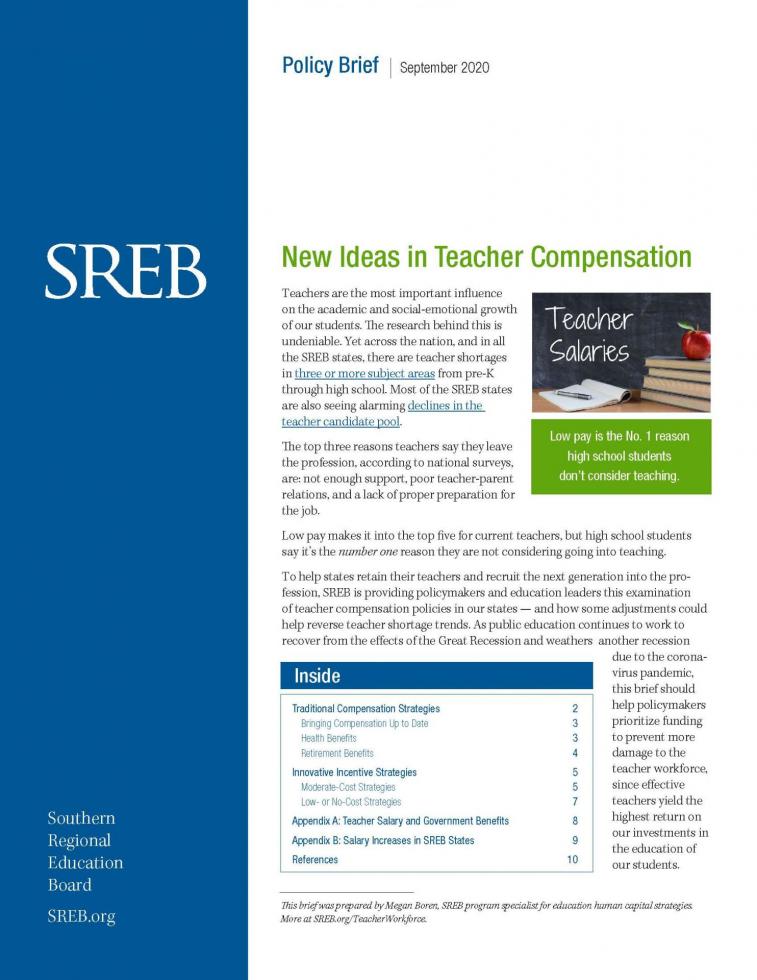Teacher Pay Needs Long-Term Changes; Actions Today Can Help Retain Teachers
Teacher compensation needs broad changes to bring salaries in line with other professionals. And even while state revenues lag during the pandemic, states and schools can take immediate steps to support educators and keep teacher shortages from worsening.
Those are among the findings of a new Southern Regional Education Board report, showing that states should continue to raise teacher pay and improve benefits and other types of support.
Teachers are the most important factor in students’ academic and
social-emotional growth, yet most SREB states have seen alarming
declines in the teacher-candidate pool. Recent college graduates
cite low pay as the No. 1 factor in deciding not to become
teachers.
“States cannot meet their workforce demands and
improve quality of life without supporting the educators who
serve our children every day,” SREB President Stephen L. Pruitt
said. “Budgets will continue to be challenging, but our students
need outstanding educators more than ever.”
Most SREB states approved teacher raises between 2016 and 2020,
according to the report, which includes salary and benefits data
on each SREB state.
Still, teacher pay has slipped nationally over the long term
after barely catching up from cuts during the Great Recession:
The average U.S. teacher salary ($58,540) in 2018-19 was
lower than the national average ($59,944) nearly two
decades earlier, when adjusted for inflation.
Mid-career teachers with bachelor’s degrees and 10 years of
experience who support a family of four now qualify for two or
more types of government assistance in 38 states, the report
says.
“Teacher compensation is not just about salaries—but also
benefits, professional development and support,” said Megan
Boren, the report’s author and a program specialist at SREB who
focuses on teacher issues. “Even during another economic
downturn, state leaders can show that teachers are respected and
valued and keep teacher shortages from worsening in the coming
years.”
In November, SREB plans to launch an interactive teacher
compensation dashboard, showing updated data on salaries,
retirement and health benefits for each of the 16 SREB
states.
Another key finding from the new report: Teachers are more likely
to receive benefits than private-sector employees, but the costs
of health insurance and other benefits for teachers vary widely
across the region.
Teachers often pay lower monthly health-insurance premiums than
most Americans, but teachers who support an entire family pay an
average of $257 more in monthly premiums than comparable
private-sector employees. The premiums are prohibitively high for
teachers in some states.
Possible strategies from the report to improve teacher
compensation:
-
Regular cost-of-living teacher raises, plus additional pay increases focused on making teacher salaries comparable to those of similar professionals.
-
Bonuses or raises for teachers in advanced teaching, mentoring and leadership roles.
-
Fixed-amount contributions to teacher-retirement systems. States also can use Medicare for teacher-retirees’ health insurance at age 65 and divert savings to salaries, training, and support.
-
Lower-cost solutions such as high-quality professional growth stipends, support for teacher well-being. and ample support staff to help teachers focus on instruction.
Media Contact: Alan Richard, cell (202) 641-1300 or
(404) 879-5528
More from SREB: Additional resources on how
states can improve the teaching profession at every phase.
A nonprofit, nonpartisan interstate compact, SREB was created in 1948 by Southern governors and legislators who recognized the link between education and economic vitality. SREB states are Alabama, Arkansas, Delaware, Florida, Georgia, Kentucky, Louisiana, Maryland, Mississippi, North Carolina, Oklahoma, South Carolina, Tennessee, Texas, Virginia and West Virginia. More at SREB.org



